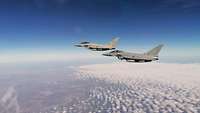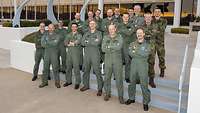The Air Force weapons instructors - in the event of a crisis, nothing works without them.
Education & Training- Date:
- Place:
- Mecklenburg-Vorpommern
- Reading time:
- 3 MIN


Immediately after Russia's renewed invasion of Ukraine in February 2022, three German Eurofighters were relocated to Romania. There, they reinforce NATONorth Atlantic Treaty Organization’s enhanced Air Policing South. It was mostly Air Force weapons instructors who prepared this mission and are now leading and accompanying it - to protect NATONorth Atlantic Treaty Organization's eastern flank.

In NATONorth Atlantic Treaty Organization's enhanced Air Policing South mission, the German Air Force, together with the Italian Air Force, monitored the airspace above Romania. Collective and defensive measures such as these serve to protect NATONorth Atlantic Treaty Organization airspace at its external borders.
Bundeswehr/PAO eAPSWith the start of Russia's war of aggression against Ukraine, NATONorth Atlantic Treaty Organization is stepping up its protection of the eastern flank of the Alliance area. Last February, the German Air Force sent more Eurofighter combat aircraft to Romania, where German and Italian Eurofighters were already jointly monitoring NATONorth Atlantic Treaty Organization airspace. The intensified missions are the result of threat analyses of Russia's systems by the Air Force weapons instructors, who develop deterrence strategies on this basis. In charge of tactics and training, they participate in mission planning with allies and thus provide their own soldiers with operational security of action.
In an emergency, the Bundeswehr's capability areas must combine their strengths and be able to act and react in an optimally coordinated manner. This applies to the flight crews just as much as to the other areas, such as the tactical air command and control service or military intelligence. The Weapons School trains professionals in these capability areas to become weapons instructors. The aim is to teach them how to effectively align the competences of their own capability area with those of other capability areas. This is necessary to successfully conduct air combat tactically and thus ultimately accomplish the missions.
The training to become a weapons instructor is initially divided into several phases, in which each area deals with complex scenarios in theory and practice. In the final training called “Baltic Hunter”, it is then a matter of combining all capability areas in order to gain and maintain air superiority - as is the case, for example, in the real mission “enhanced Baltic Air Policing” (eBAP). The following approach also applies to this training: "National and Alliance defense cannot be accomplished by going it alone".
Cooperation between the Netherlands and Germany is not new. In the first course of the Air Force Weapons School, the two nations already worked together in the training of their weapons instructors. But this year, for the first time, F-35 jets from the Koninklijke Luchtmacht of the Netherlands will be integrated into the flying training segments of the course in German airspace. By connecting the German and Dutch training of both weapons schools, the Air Force is also supported in its preparation for introducing the F-35.

In February, a German delegation of experts visited Lockheed Martin in the USA for the first time. The Air Force Weapons School was also represented in the delegation, since its training contents already include the requirements of the …
Frank SwinkelsThe procurement of the world's most modern combat aircraft, the F-35, was a consequence of the military requirements following the announcement of what is called the Zeitenwende or watershed era. In cooperation with Dutch and USUnited States partners, the Air Force Weapons School already prepares the future weapons instructors of this year's course for the operational requirements of this watershed era. However, it does not confine itself to this task but also incorporates upcoming types of operations with the F-35, the fifth-generation combat aircraft, into the training.
The procurement of a new weapon system does not only entail adapting the demands made on personnel, materiel and infrastructure. Tactics, training and mindsets also need to be further developed. This year's weapons instructor course started in March and lasts about seven months.
by Elisabeth Schöneberg, Rene Gutjahr